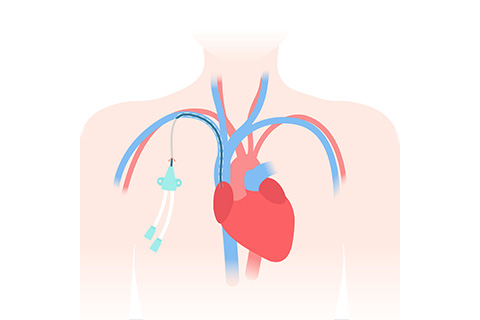
The right side of the heart is responsible for receiving blood from the rest of your body and sending it to your lungs to get oxygenated. Oxygenated blood is then returned from the lungs to the left side of your heart for sending back out to the rest of your body and brain. Right heart catheterization (RHC) is done when there is a suspicion of high blood pressure in the lungs or pulmonary hypertension. It is the “gold standard” test that is done to measure pulmonary pressures.
During the procedure, the doctor measures pressures inside the chambers on the right side of your heart, including the right atrium and right ventricle. A cardiologist working in tandem may take indirect measurements of pressures on the left side of your heart during the same procedure. All these measurements are used to diagnose lung and heart conditions and to determine what treatment might be right for you.
Like all procedures, right heart catheterization carries some risks. These may include:
Other rare complications may include:
During the procedure, which is done is a specialized procedure room, you will be connected to an electrocardiogram (ECG) monitor, which records the electrical activity of your heart. You will be given a mild sedative to help you relax.
Your healthcare provider will clean and numb the skin over your neck or groin with a local anesthetic. A small needle will be used to find your vein. Then, your doctor will insert a thin tube called a catheter into your vein.
Your doctor will place an introducer sheath (a slightly larger, hollow tube) into your vein first and will then insert a thin catheter through the introducer. Once the PA catheter is in place, your heart pressure will be measured.
After the procedure, a medical staff member will put pressure on your insertion site to ensure you are not bleeding. If your neck vein was used, you can sit up comfortably. If a groin vein was used for the procedure, you will have to lie flat in bed for a few hours so the puncture site can heal properly.
You can eat and drink normally after the procedure. The nurse will monitor the insertion site for bleeding and check your blood pressure, heart rate, and breathing while you recover. Let the nurse know if you have any chest pain or trouble breathing.
Your healthcare provider will discuss findings and plans for treatment if necessary. Most of the time, you will be able to go home a few hours after the procedure.
Once at home, watch the insertion site for bleeding, unusual pain, swelling, and abnormal discoloration or temperature change at or near the insertion site. A small bruise is normal. If you notice a constant or large amount of blood at the site that cannot be contained with a small bandage or dressing, call your healthcare provider. Your health and well-being are Redwood Pulmonary’s top priorities, and we are here to address any concerns or issues that may arise.
To request more information, please call (650) 367-5636 or contact us online today!
Redwood Pulmonary Medical Associates
170 Alameda de las Pulgas
Redwood City, CA 94062
Phone:
(650) 367-5636
Get Directions